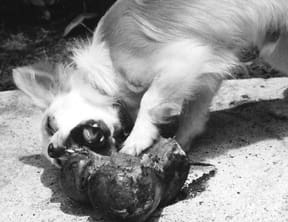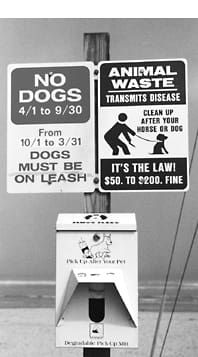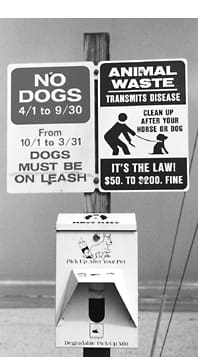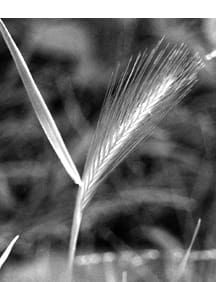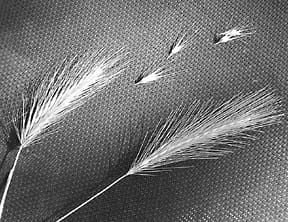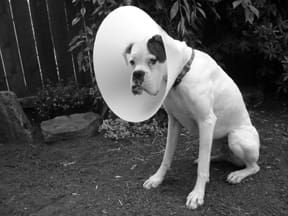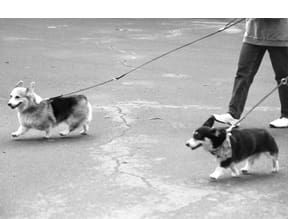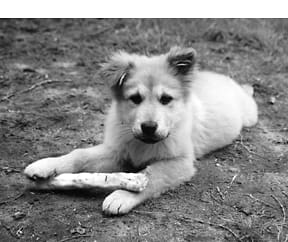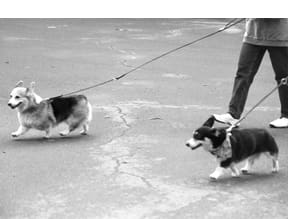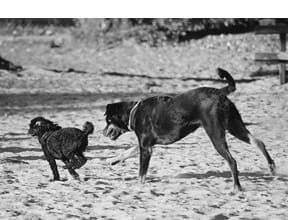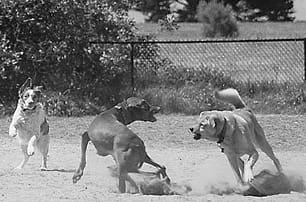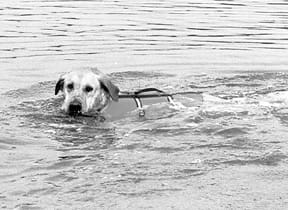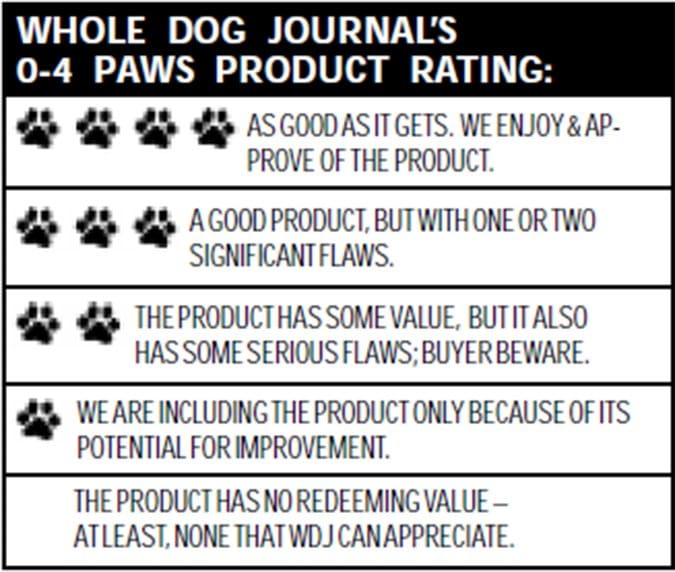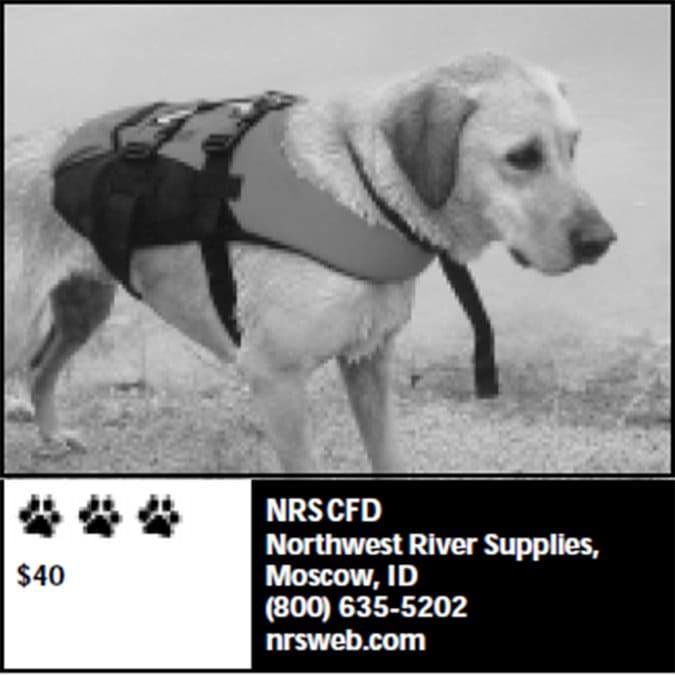By Pat Miller
Dominance has become something of a dirty word in many dog-training circles, and for good cause. Behaviorists once used the word to appropriately define a relationship between two individuals in a social group. However, over recent decades, the word has been warped and twisted to inappropriately describe an assertive dog’s personality.
Sadly, “dominance” has often been used as justification to inflict a litany of punishment on dogs, especially those dogs who react defensively to force-based training methods. In the past, if a dog responded to compulsion-based training or punishment by defending himself with a growl or snap, this was interpreted as dominance and defiance. In addition, many natural, normal dog behaviors, such as the desire to sleep on soft surfaces (beds and sofas), jumping up in greeting, and an eagerness to dash through doorways to get to the great outdoors, were also interpreted by some people as “dominant” behaviors that needed correcting.
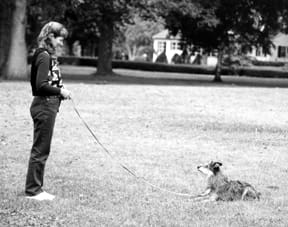
According to these outdated theories, a dog’s owners should be the only dominant figures in the household, and they were exhorted to establish dominance over their dogs by being forceful. We were cautioned by our trainers and by the dog-training books of the day not to tolerate any of our dogs’ resistance – and warned that if we failed to fiercely squash any opposition, disaster would ensue. We were urged to leap to the offense if a dog objected to our rough handling, and told to apply violent techniques such as scruff shakes and alpha rolls if our dogs dared resist.
Some trainers went even further, advocating extremely abusive methods such as hanging a dog by the choke chain and leash, “helicoptering” him in the air at the end of a chain and leash, or holding his head in a hole filled with water until unconsciousness, for behaviors ranging from something as mild as digging to as serious as aggression.
We’re past that
Fortunately for dogs, modern behavioral science has moved past the simplistic notion that a dog owner’s absolute dominance will solve all (or any) of a dog’s behavior or training issues. This is especially true in cases involving a dog who “fights back” when physically hurt or frightened. Severe physical punishments may force a dog to comply, but this can cause the dog to fear the person meting out the punishment, or become violent in return.
Today’s positive trainers recognize the importance of the relationship between dogs and their owners, and realize that, while force-based methods can effectively train dogs, they also risk damaging the relationship between dog and owner, sometimes beyond repair.
Gentle, humane training methods are as effective as pain-based techniques (if not more so) and can accomplish the same training goals without force and the attendant risk of negative reactions such as fear and aggression that are possible whenever force is applied.
Learning to lead
A good leader doesn’t need to be violent – she simply needs to create an environment where it is easy and rewarding for her followers to comply with her wishes, and difficult for them to make mistakes. She helps them succeed. Attending a positive training class with your dog is a good place to start establishing yourself as a benevolent leader to your dog. A training class helps you and your dog understand each other better, and your trainer can help the two of you problem solve if the road gets bumpy along the way.
A successful leader/owner controls valuable resources, and shares them with her dogs generously and judiciously. Appropriate behaviors earn rewards. Inappropriate behaviors do not. If resources are consistently awarded on the basis of desirable behaviors, and withheld in the presence of undesirable behaviors, what dog in his right mind would not choose to be well-behaved? It’s no different than teaching a toddler that he has to say “Please” to get a cookie rather than scream “Gimme!” at the top of his lungs while his face turns blue.
Dominance myths
When the “you have to dominate your dog” concept was in vogue, many trainers instructed their clients to establish “dominance” (used incorrectly here) over their dogs. This was supposed to be accomplished by, among other things, eating before the dog eats, going through doorways before the dog, and routinely rolling the dog on his back in a show of force.
Fortunately, current and more in-depth behavior studies have shown that in wild and domesticated dogs, it’s not true that the pack leader always eats first, goes through doorways first, or routinely rolls other pack members onto their backs to keep them in line. She may be able to do all those things if she wants, but it really is in the pack’s best interest – and hers – to be in a state of equilibrium that doesn’t involve a constant show of force.
When there is plenty of food to go around, there is no need for the pack leader to assert herself at the feed trough. If she is eager to go through a door, she may choose to go first, in which case lower-ranking pack members defer to her.
And anyone who has ever watched dogs greeting and interacting quickly realizes that a “belly-up” posture on the part of a subordinate dog is usually voluntary. In fact, this voluntary submission posture normally triggers a response in the more assertive dog to call a truce. If one dog violently forces another onto his back and/or ignores the subordinate dog’s voluntary attempt at appeasement, the “underdog” is probably fighting for his life.
Similarly, the dog who is gets alpha-rolled by an owner may fear for his life and, terrified by his owner’s inexplicable violence, fight back accordingly.
Lower-ranking pack members show their deference to the leader with a number of body-language behaviors. Our Scottie, Dubhy, has learned the fine art of appeasing our very assertive Kelpie by keeping his eyes averted to avoid Katie’s intense Kelpie glare. As long as he avoids eye contact, she lets him pass without comment. He has, in essence, learned to say “please.”
Teaching your dog to “ask”
Your dog need not physically submit to you by offering his vulnerable underside – he only needs to defer. There are a number of quick and easy exercises you can insert painlessly into your daily routine to remind your dog that you are in charge of the resources, and he receives them thanks to your benevolence.
Say Please for Meals: It is perfectly okay to feed your dog before you eat your own meal – as long as you remind your dog that you control the food bowl. For starters, there should be no free-feeding. If your dog can pick from his dish whenever he wants, you allow him to believe that he controls the very valuable food-bowl resource, and you miss a golden opportunity to reinforce deference one or more times a day. (I feed my adult dogs twice a day.)
Each mealtime, after preparing your dog’s food, lift the bowl off the counter with his meal in it, and hold it at your chest. Wait for him to sit. If necessary, move the bowl over his head to lure the sit, or ask him to sit verbally. When he sits, tell him he’s a good boy and lower the bowl toward the floor. If he starts to get up, cheerfully say “Oops!” and lift the bowl to chest level again. Keep doing this until you can set the bowl on the floor without him moving. Then tell him “okay!” and encourage him to eat.
This is actually engaging in a little friendly food-guarding, a concept his canine brain should grasp easily. You are saying, “This food is really mine, because as leader all things belong to me, but because I’m nice I’m letting you have some of my food.”
Say Please to Go Outside: Anytime you are going to open a door to the outside world, ask your dog to “Wait!” (See “Wait a Bit, Stay a While,” WDJ, May 2001.) Open the door a crack, and if he starts to go through, say “Oops!” and gently close the door. Caution: do not slam the door on his nose! Then tell him “Wait!” and open the door a crack again. If he stays still, tell him he’s a good boy and close the door again. Gradually work up until you can open the door wide and he doesn’t go through unless you tell him he can.
Sometimes you will release him with an “okay” so he can run out the door into his fenced yard; sometimes you will go through the door and then invite him out; and sometimes you will go through and close it behind you, leaving him in the house.
You are telling him, “This is my door. I get to decide who goes through, and when. Sometimes you can go first, sometimes I go first, and sometimes you don’t get to go through at all.”
If you have more than one dog, vary the order in which you release them so that each goes first some of the time.
Say Please for Treats: Take advantage of every opportunity to instill “sit” as a default behavior – the thing the dog will do when he’s not sure what to do. Instead of popping a treat in his mouth just because he’s cute and you love him, wait for a sit – then pop the treat in his mouth. You are telling him, “These are my treats, and I will share them with you if I feel like it. You can make me feel like it by sitting.” A gratuitous treat is a missed opportunity to reinforce “sit” as his default behavior.
Say Please for Greeting: When your dog runs up to greet you, all excited because he hasn’t seen you for at least three full minutes, watch him closely. If he gathers himself to jump on you, say “Oops!” and turn your back. Watch him over your shoulder, and when he settles solidly on all fours, or even better, sits (because that has become his default behavior) say “Yes!” and turn back to greet him. If he jumps up, turn away again. Keep repeating until he will sit politely to be greeted.
You are telling him, “I am the leader, and as leader, my greeting is a valuable resource that I only give to dogs who are sitting.”
Say Please for Fun: Does your dog like to chase the ball? Play tug-o-war? Visit with his canine pals at the park? Go for a ride in the car? A walk on the leash? A swim in the pond? Precede all his favorite activities with a polite sit. “Sit” makes the ball go. “Sit” brings the tug toy to dog-mouth level. “Sit” gets the leash attached for a walk, or removed for a romp in the park. “Sit” elicits the release cue for a dive into the lake. “Sit” makes all good things happen.
If you want to take it a step further, “sit” makes the ball go, but the dog can only go when you give him an “Okay!” or “Go” release cue. Similarly, “sit” lowers the tug toy to mouth level, but he can only grab it when you say, “Take it!”
You are telling him, “I control all these wonderful resources – you can have access to them at my whim and pleasure, when I decide you can, and not before.”
Say Please for Attention: Rather than allowing your dog to demand your attention, make him ask by – you guessed it – sitting. If he is a big dog and you are sitting in a chair or on the sofa, a “down” is an even better “please” for attention.
You are telling him that this very valuable resource (your attention) must be earned with a sit or a down; he doesn’t get it on demand.
Kindly controlling
You should be getting the picture by now. The more assertive your dog’s personality, the more important it is that you control as many available resources as possible, and are consistent about paying them out for appropriate behavior. Whatever your dog’s personality, the better you are at controlling resources and awarding them for desirable behavior, the better behaved your dog is likely to be.
The benevolent leader concept comes naturally for some people. These are the folks who always seem to end up with well-mannered dogs without appearing to think much about it – it just happens. Either they were born with good “animal instincts,” or they had good human models to imitate from an early age. If it doesn’t come to you naturally, don’t despair, you can learn! Just start asking your dog to say “Please!” for everything you can think of.
-Pat Miller, WDJ’s Training Editor, is also a freelance author and Certified Pet Dog Trainer in Chattanooga, Tennessee. She is the president of the Board of Directors of the Association of Pet Dog Trainers, and published her first book, The Power of Positive Dog Training, in 2001.


